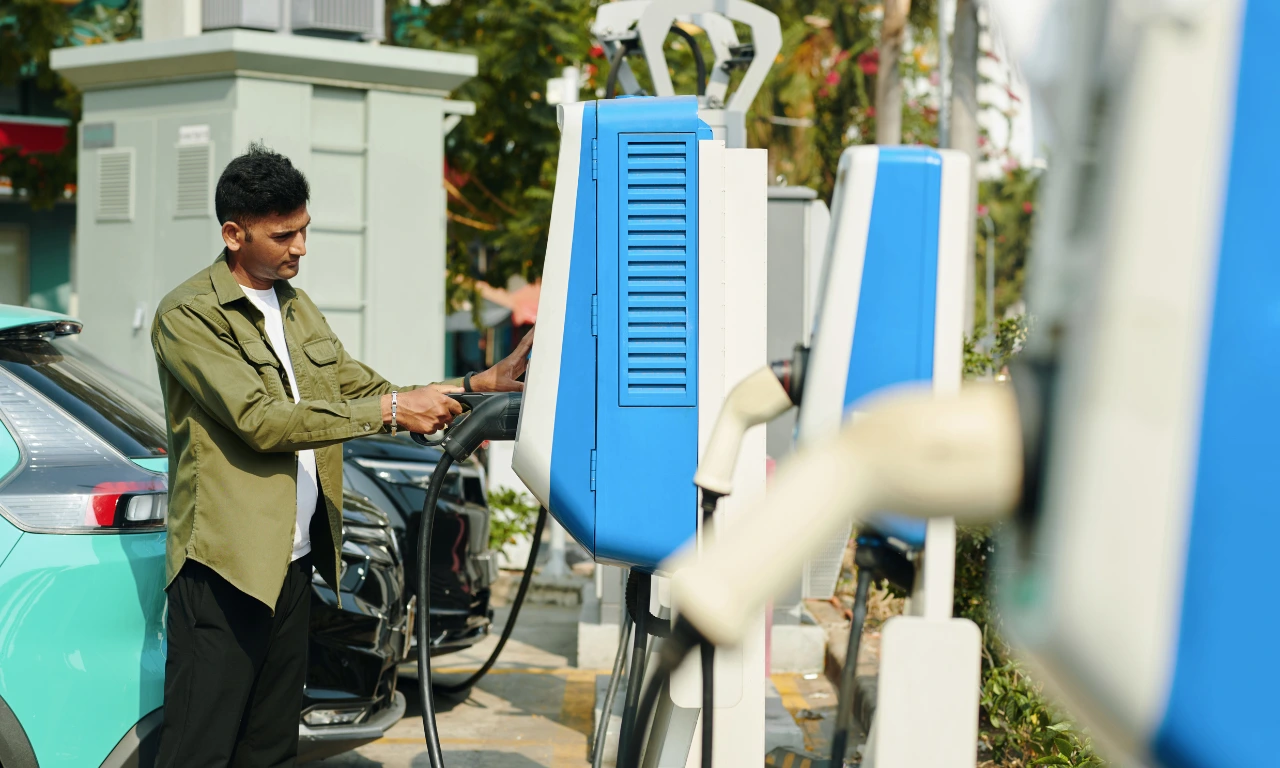EV Financing Market Size 2025-2030: Growth Drivers & Barriers

The global shift toward electric mobility is accelerating, and India is no exception. With electric vehicle (EV) sales crossing the 1.5 million mark in FY2024 and projected to contribute nearly 30% of all new vehicle sales by 2030, the market trajectory is clear: EVs are no longer a niche, but a mainstream growth engine. Yet, beneath this optimism lies a critical bottleneck financing.
Unlike traditional internal combustion engine (ICE) vehicles, EVs come with unique challenges such as higher upfront costs, uncertain resale values, and the absence of long-term performance benchmarks. These factors elevate financing risk for lenders, leaving many potential buyers unable to access affordable credit. For original equipment manufacturers (OEMs), the inability to scale financing solutions directly impacts sales velocity and market penetration.
This article explores India’s EV financing market size for 2025–2030, the growth drivers propelling expansion, and the barriers that could hold it back.
Market Outlook 2025–2030: Size, Growth, and Momentum
India’s EV financing market is set to witness rapid expansion, in line with the country’s broader electrification targets. Based on current projections:
-
EV Retail Financing Volume: Expected to grow from ₹45,000 crore in 2025 to over ₹1.5 lakh crore by 2030, implying a CAGR of 27–30%.
-
Penetration of Financing in EV Sales: Today, only 60% of EV purchases are financed compared to 75–80% for ICE vehicles. By 2030, financing penetration is likely to cross 80% as lenders develop specialized EV loan products.
-
2W & 3W Dominance: Two-wheelers (E2Ws) and three-wheelers (E3Ws) will account for 75% of financed EV units by 2030, given their role in daily commuting and last-mile logistics.
-
Passenger EVs: Car financing will scale as battery prices decline and mass-market EVs enter the sub-₹10 lakh bracket, though growth will be skewed toward metro and Tier-1 markets in the short term.
-
Commercial Fleet Financing: Financing for e-buses, fleet cars, and logistics vans will accelerate with corporate ESG mandates and state transport electrification programs.
Globally, the EV finance market is projected to cross ₹39.6 lakh crore by 2030. India’s contribution while smaller in absolute size will be strategically significant given its high population, rapid urbanization, and push for localized EV manufacturing.
Growth Drivers
The electric vehicle (EV) financing ecosystem in India is gaining momentum, supported by structural market shifts, progressive policies, and innovation in lending models. Key growth drivers include:
1. Rising EV Demand and Market Economics
Consumer interest in EVs is rising sharply, driven by falling battery prices (expected to decline below USD 100/kWh by 2027), rising fuel costs, and growing awareness of climate change. As total cost of ownership (TCO) parity approaches, more consumers will seek financing to make upfront purchases viable. OEMs are already reporting financing requests for EVs growing faster than their ICE counterparts.
2. Government Push and Policy Incentives
India’s policy environment is strongly supportive of EV financing:
-
FAME-II subsidies reduce upfront costs for 2Ws and buses, indirectly lowering loan sizes.
-
State EV policies (Delhi, Maharashtra, Gujarat) provide direct subsidies and road-tax waivers, making loans more attractive.
-
Priority sector lending classification for EVs is under active discussion, which could reduce lending rates and improve access.
-
Battery-as-a-service and leasing pilots are being incentivized, opening new financing categories.
3. OEM–NBFC Partnerships
OEMs are recognizing financing as an integral part of their sales strategy. Partnerships with NBFCs and fintech lenders have proliferated. Examples include:
-
Tata Motors and State Bank of India’s EV loan programs with low interest rates.
-
Ola Electric’s collaboration with NBFCs for 2W retail financing.
-
Hero Electric’s tie-ups with credit cooperatives to penetrate Tier-2/3 markets.
These partnerships enable tailored loan products with lower EMIs, flexible tenures, and bundled insurance, driving adoption.
4. Digitization and Fintech Innovation
The lending landscape is being reshaped by digital platforms:
-
Instant loan approvals through mobile-first journeys.
-
AI-driven credit scoring based on alternative data (e.g., UPI transaction history, e-commerce spends).
-
Embedded finance models where loan offers are built into OEM showrooms and online booking flows.
-
BNPL-style financing emerging for battery leasing and micro-mobility EVs.
Digitization also reduces underwriting costs, enabling lenders to serve lower-ticket E2W loans profitably.
5. ESG & Investor Momentum
Global investors are increasingly channeling funds toward green mobility. EV loan securitization and green bonds are gaining traction, offering lenders cheaper cost of capital. OEMs with strong ESG narratives can leverage this to negotiate better financing terms for customers.
Barriers
Despite strong tailwinds, several structural and operational challenges continue to constrain the scale of EV financing in India. These barriers include:
1. High Upfront Cost and Resale Uncertainty
EVs, especially passenger cars, are still 25–40% more expensive than their ICE counterparts. Even with falling battery costs, the resale value of EVs remains uncertain due to rapid technology changes. For lenders, this creates residual value risk, reducing loan-to-value (LTV) ratios and increasing EMI burden for buyers.
2. Limited Risk Appetite Among Lenders
Most traditional banks remain cautious about EV loans, particularly in rural and semi-urban markets. Concerns include:
-
Higher default risk in case of technology failure.
-
Lack of historical performance data on EVs.
-
Difficulty repossessing and reselling EVs due to thin secondary markets.
This has led to NBFCs and fintechs carrying the bulk of the financing load, which limits scale.
3. Infrastructure Bottlenecks
The financing ecosystem is deeply linked to EV adoption, which in turn depends on charging infrastructure. Slow rollout of public chargers, range anxiety, and grid capacity issues directly impact consumer willingness to commit to long-tenure loans. Financing models that assume high utilization (e.g., fleet EV loans) are particularly vulnerable to infrastructure gaps.
4. Credit Penetration in Tier-2 and Tier-3 Cities
While Tier-1 markets like Delhi, Bengaluru, and Mumbai are leading EV adoption, rural and semi-urban penetration remains low. Limited formal credit histories, reliance on informal lending, and lack of awareness among local financiers create barriers. Given that these regions account for over 60% of India’s 2W sales, this is a significant challenge for OEMs aiming at mass adoption.
5. Evolving Battery Technology Risks
Battery degradation and warranty terms are a key concern for both consumers and lenders. If resale values are uncertain, lenders lower LTV ratios or shorten loan tenures, which raises upfront EMI costs. Until standardized battery health certificates and residual value benchmarks are developed, financing risk will remain elevated.
6. Policy Uncertainty and Subsidy Tapering
While policies like FAME-II and state subsidies are driving adoption, most are time-bound and subject to revisions. Subsidy withdrawal in China led to a temporary sales slump in 2020, showing the risk of over-dependence. As India gradually reduces subsidies, financing models must adapt to a market-driven equilibrium.
Case Example :
Ola Electric – Democratizing EV 2W Financing with NBFC & Fintech Tie-Ups
Ola Electric disrupted the 2W market by positioning its scooters as aspirational yet affordable. Financing strategy was a core part of its go-to-market.
-
The Problem: Two-wheeler buyers are highly price-sensitive, and many depend on informal lenders. NBFCs were initially reluctant due to lack of credit history in semi-urban buyers.
-
The Intervention: Ola set up partnerships with over 25 NBFCs, MFIs, and fintech lenders. Key innovations included:
-
Low-ticket EMIs starting from ₹2,000/month, with flexible repayment linked to income cycles.
-
AI-driven underwriting using UPI transaction data and digital KYC.
-
Bundled products with insurance and extended battery warranty.
-
The Result: Ola claims financing coverage across 1,000+ cities and towns, with over 60% of buyers using formal loans. Importantly, it expanded EV adoption in Tier-2/3 markets, creating a demand base beyond urban early adopters.
-
Lesson for OEMs: Mass-market adoption requires breaking traditional lending silos. Partnering with fintechs and MFIs can unlock new customer pools that traditional banks often overlook.
Strategic Implications for OEMs
For OEMs, the path is clear: without robust financing, EV adoption targets will remain aspirational. Key imperatives include:
-
Develop Captive Finance Arms: Following global best practices (Tesla Finance, BYD Finance), OEMs should explore dedicated lending arms to reduce dependence on external NBFCs.
-
Invest in Digital Financing Journeys: Embedding finance into online and offline sales touchpoints creates a seamless consumer experience.
-
Collaborate on Residual Value Standards: OEMs, lenders, and regulators must work together to establish resale benchmarks and battery certification norms.
-
Expand Financing Access Beyond Metros: Tier-2/3 outreach via microfinance institutions, cooperatives, and digital lenders will unlock mass-market growth.
-
Leverage ESG Capital: Aligning with sustainability-linked financing sources (green bonds, carbon credit monetization) will reduce the cost of capital.
Conclusion: Financing as the Growth Catalyst
India’s EV journey between 2025 and 2030 will not be defined solely by charging stations, subsidies, or technology breakthroughs. The true enabler will be financing. Without affordable, accessible, and innovative loan products, EV adoption will stall at urban elite levels. With them, however, India can achieve its EV30@30 target, empower consumers across income segments, and establish itself as a global leader in green mobility.
For OEMs, the message is clear: your finance strategy is your growth strategy. Partnering deeply with lenders, investing in digital finance journeys, and co-creating risk-mitigation models are no longer optional they are competitive necessities.
The next five years will determine whether India’s EV market matures into a robust, inclusive ecosystem or remains constrained by affordability barriers. The opportunity is massive. But capturing it requires treating financing not as an afterthought, but as the very engine of EV sales.
FAQs
Q1.Why is EV financing important in India?
Ans.India’s EV revolution is driven by policy, awareness, and technology. Growing demand makes reliable financing essential.
Q2.How EV financing works?
Ans.Financial entities, especially startups, are driving EV financing through models like fleet ownership, reverse leasing, and flexible loans. To scale and expand reach, they need greater access to capital.
Q3.How can EVs be financed?
Ans.An SPV or institutions like IREDA/NABARD can fund EV purchases, and post–proof of concept, raise capital from global and domestic lenders to expand the lending pool.
Q4.Which companies are transforming mobility by EV financing?
Ans.Firms like Vidyuttech, OTO, Alt Mobility, and RevFin are driving EV financing in India. The nation’s EV revolution is accelerating, fueled by technology, sustainability, and government support.








